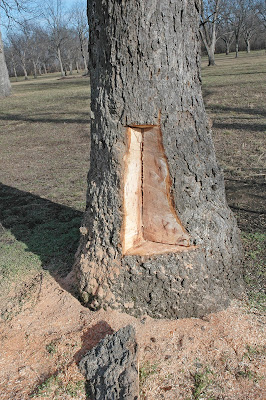I have visited many native pecan
groves over the years and have always found at least one tree in each grove
that has developed a swollen, disfigured lower-trunk. Trees with this condition
are typically weak nut producers and often suffer from significant limb loss. As
I work with growers to improve their native groves, I always recommend removing
these unhealthy trees.
The swollen lower trunk condition is most
prevalent under two types of growing conditions: Trees growing under extremely wet soil
conditions (photo at right) or pecan trees growing in shallow soils along upland creek
bottoms. In both cases the
trees are growing under water stress. I the first case, the tree and its root
system is swamped by too much water while the tree growing on the upland site
frequently suffers mid-summer drought. Less frequently, trees can develop a
swollen lower trunk even when growing in close to ideal soil conditions.
While making plans to thin trees in
our native groves this winter, I decided it was time to remove an unhealthy
tree with a swollen lower trunk (photo at left).
But I’ve always wondered -- What is going on inside the trunk to make it
swell like that? It was time for a closer look.
I started by looking at the bark all around the lower portion of the
trunk. The affected tree had several obvious wounds that looked just like old
pruning wounds (photo below). However, this tree has not had a limb removed from the
lower portion of the trunk for more than 60 years. In that amount of time, an
old pruning wound should have completely disappeared. Something else was
causing these wounds in the bark. With further inspection of the lower trunk, I
also found a nectria canker and a phomopsis gall (photo below).
 |
| Wounds visible in the bark of a swollen trunk |
 |
| Nectria canker on the left and Phomopsis gall on the right |
By looking at the bark of the
tree, I could tell that several pathogens were infecting the lower portion of
this tree’s trunk. However, I really wanted to find out what was going on
inside this tree’s trunk to cause the trunk to swell. I used my chainsaw to cut a section out of
the lower trunk area so I could look at patterns of wood growth (photo at right). The
piece of wood I cut from the tree extended from just above the point of
swelling downwards towards the soil surface. Once I removed the trunk segment
from the tree, I took the wood into my shop and sanded the vertical face
perfectly smooth to reveal the wood grain (photo below).
Before I show you some of the wood
deformities I found inside this tree, I think it is important to show you what
normal wood growth looks like when cut longitudinally. Thephoto at right shows a section
of pecan wood with a normal wood growth pattern. The annual growth rings, so
easily recognized when a pecan tree is cut in cross-section, are a little
harder to see this longitudinal slice through the wood. However, you should be
able to see the alternating pattern of large-pore, spring wood and finer
textured summer wood that provides a visual record of annual cycle of wood
growth.
Towards the upper portion of the
wood sample, I found what can generically be called a wood burl (photo at left).
Growing outwards from a bark inclusion (the black crevasse in the wood) you can
see deformed wood growth that almost appears like it is bubbling outwards
towards the surface of the outer bark. Lower down on the trunk segment, I found
multiple burls both near the surface and deep inside the wood (photo below). In
every case, the deformed pattern of wood growth seems to have originated with a
wound in the wood.
After cutting into this tree, it
is clear that trunk swelling at the base of pecan trees is due in large part to
the development of burl wood. Burls can form in response to either fungal or
bacterial infections but how these organisms penetrated the tree trunk is the
real key to understanding lower trunk swelling. Each burl was formed in
association with an injury in the wood. These injuries were most likely created
sometime in the past by the feeding of wood boring insects. Trees that grow
under stress (too much or too little water) seem to attract both dogwood borers
and flat-headed apple tree borers. The movement of these insects in and out of
the tree’s trunk most likely spread the pathogens responsible for burl
formation and ultimately leads to swelling of the lower trunk.






